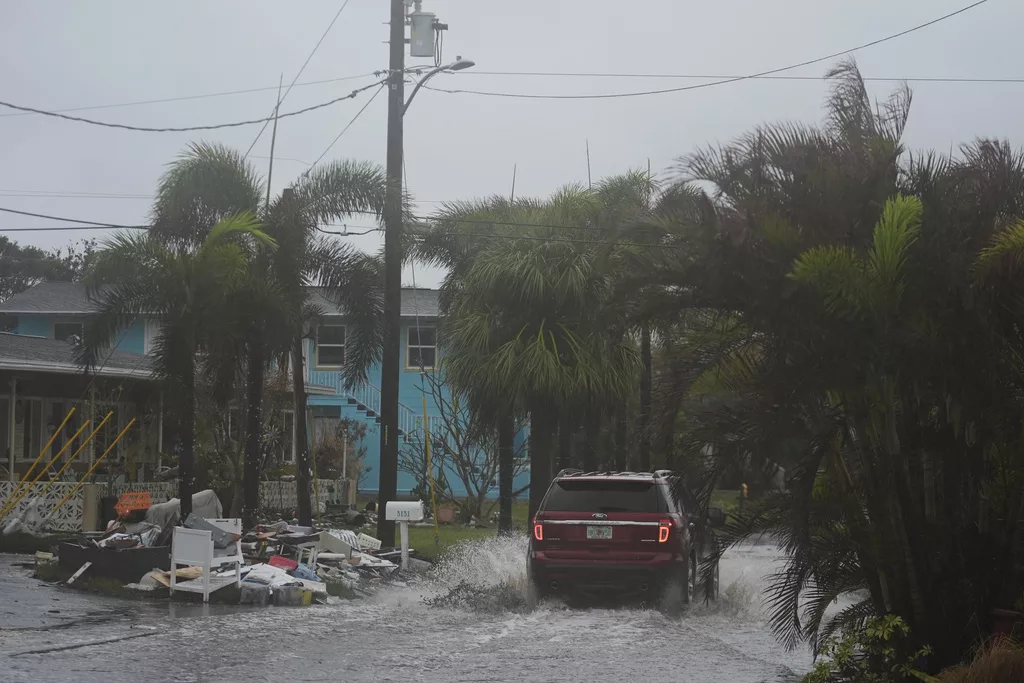Polluted Waste from Florida’s Fertilizer Industry in the Path of Milton’s Fury
As Hurricane Milton batters Florida’s west coast with powerful winds and flooding, environmentalists are raising alarms about the potential spread of hazardous waste from the state’s phosphate fertilizer mining industry. A particular concern is the more than 1 billion tons of radioactive phosphogypsum waste stored in 25 massive stacks across central Florida. These waste stacks, vulnerable to storm damage, sit dangerously close to key waterways, making them potential ticking time bombs in Milton’s path.

Phosphate Waste Threatened by Hurricane Milton
Phosphogypsum, a byproduct of phosphate ore processing for fertilizer, contains radium and radon—both radioactive and carcinogenic. Additionally, it harbors toxic heavy metals such as arsenic, cadmium, and mercury. These hazardous materials pose a significant risk if released into the environment during extreme weather events like Hurricane Milton, which made landfall with Category 3 strength, bringing 120 mph winds, a storm surge, and up to 18 inches of rainfall.
The Piney Point wastewater reservoir, located near Tampa Bay, is particularly vulnerable. Over the years, it has suffered multiple structural failures, leading to significant environmental damage. A leak in March 2021 released 215 million gallons of polluted water into the bay, resulting in massive fish deaths. Another leak in August 2022 discharged 4.5 million gallons of wastewater. With the site’s former owner, HRC Holdings, having filed for bankruptcy, the reservoir is now managed by a court-appointed receiver, further complicating mitigation efforts.
Historical Precedents and Current Concerns
Florida’s phosphate industry has long been linked to environmental hazards, particularly during hurricanes. For example, in 2004, Hurricane Frances, a Category 2 storm, caused 65 million gallons of acidic wastewater from phosphogypsum stacks to leak into nearby waterways, killing fish and marine life. Now, with Hurricane Milton’s path set to cross central Florida, the risk of a similar or worse disaster looms.
The Mosaic Company, the nation’s largest phosphate producer, owns several waste stacks across the state, including two at its Riverview facility near Tampa Bay. A sinkhole opened beneath Mosaic’s New Wales Gypstack in 2016, sending millions of gallons of contaminated waste into Florida’s drinking water aquifer. Although Mosaic stated that there were no offsite impacts, the area remains at risk of further damage from Hurricane Milton.
In preparation for the storm, Mosaic emphasized that it has updated its preparedness and response plans, reviewed lessons from previous hurricanes, and ensured that all equipment, such as pumps and generators, is in place. However, the threat remains significant given the scale of the storm.
Broader Environmental Hazards in the Tampa Bay Area
Beyond the phosphate waste stacks, the Tampa Bay area is home to other toxic sites, including the former Stauffer Chemical Co. pesticide production facility, which has polluted the Anclote River, groundwater, and soil. This site is now part of the EPA’s Superfund program and has been undergoing cleanup for years. With Hurricane Milton approaching, the EPA has assured the public that measures are in place to secure the site against potential damage.

The Florida Department of Environmental Protection has also mobilized to protect the state’s critical facilities, parks, and preserves from the storm’s effects. Yet, with the hazardous waste scattered across the state and the intensity of the storm, environmentalists remain deeply concerned about the long-term impact Hurricane Milton could have on Florida’s fragile ecosystems.


Comments are closed, but trackbacks and pingbacks are open.